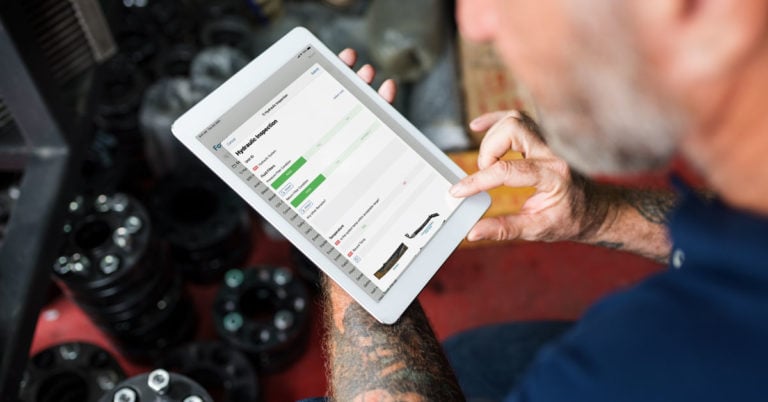You likely know of IoT, or Internet of Things, as it’s gained popularity over the last decade. However, for many, it’s a broad and sometimes vague concept without clear benefits. So, we’ll start with defining IoT and cover the benefits of integrating it in your business, especially for condition monitoring.
IoT is physical objects that have built-in processing ability, software, sensors, or other technology that connects them to a digital network. This allows the physical objects to collect and send data via a wireless network. According to the International Data Corporation, there will be 41.6 billion IoT-connected devices by 2025.
While connected devices are at the core of IoT, the real benefits come from the data. IoT makes data collection infinitely easier and eliminates manual input, but that’s where it stops. In fact, businesses that invest in IoT sensors or connected devices often overlook the most important step. This sudden influx of data means you need a system in place to process, analyze, and take real action from the data.
Examples of IoT Integration
The first implementation of a connected device was in 1982. The Carnegie Mellon University Computer Science Department linked a Coca-Cola vending machine to the department’s main computer. Micro-switches in each row of the machine would report the inventory level and whether the drinks were cold or not. However, the only thing missing was integration with software that could automate refill notifications or signal when drinks are not being cooled.
Today, we have the technology to take action from IoT data. Redlist integrates with in-line sensors to improve asset maintenance through automation and access to real-time condition monitoring data. For example, in-line oil analysis sensors paired with Redlist allow you to optimize your oil change intervals. It eliminates the manual labor to collect the oil data and the guesswork around remaining oil life. Collecting oil data without a way to easily analyze the data and take action is when IoT is less beneficial. Redlist efficiently solves this problem and can be automated and configured to your needs. Configuration includes setting thresholds that trigger automatic notifications for maintenance, inspection, and more.
Benefits of IoT Integration
1. Communication
The Internet of Things does not require human involvement. There is constant feedback taking place without any paid manual hours. Digitizing your data collection with IoT can give back some time in your employees’ day to put toward other business objectives and projects. This is better for everyone, as you and your team can use that saved time to focus on the actual data instead of collecting it. Additionally, your data accuracy improves as the potential for human error is eliminated.
2. Real-Time Data Management
To make the most effective decisions, you need accurate and up-to-date information. With paper or spreadsheet-based systems, data has to be collected or tracked down and manual input is required. That all takes time, so you’re typically not looking at real-time data. Back to the vending machine example, your spreadsheet may say that Joe checked 4 hours ago and the vending machine was full. You may make the trip only to find an empty machine because you weren’t looking at real-time data to make your decision. With oil analysis, you could manually inspect your equipment’s oil level and condition on a weekly basis. But, knowing the oil status today can make the difference in preventing machine failure between those weekly inspections.
3. Automation
We’ve established constant, real-time communication between systems, now to extract the benefits of that. Automation allows you to leverage IoT and take action based on the data collected. Redlist enables you to automate maintenance by triggering digital work orders. This bridges the gap between IoT and your employees. You can finally achieve the predictive maintenance program you’ve always wanted or optimize your current maintenance plan.
4. Reporting
Having access to real-time data is one thing, but being able to quickly analyze and understand it is another. Redlist auto-populates your data into reports that provide visibility into your IoT. This level of effortless reporting saves you and your team even more time by eliminating double data entry. Furthermore, powerful reporting ensures you can spot trends faster, make educated decisions, and accelerate your business growth.
5. Increased Efficiency
All of the data and reporting creates opportunities for widespread improvements in efficiency and cost reductions. A simple example is IoT-connected lights. They can be set to turn on only when an area is in use or have automation settings to turn lights on or off based on business hours, reducing the electric costs. The in-line oil analysis example results in an average 50% cost reduction as those businesses double the use of their oil. This integration saves time checking the oil, reduces time spent changing oil, and eliminates the data entry to create a work order. Plus, the business decreases the volume of oil used and the resulting impact on the environment.

Integrate IoT with Redlist
IoT integration is only getting better as the technology continues to improve. You can implement IoT in nearly any setting, so the actual possibilities for your business are almost endless. At the very least, it will improve equipment maintenance, identify issues before failure, maximize equipment life, save time and money, and offer greater visibility down to a granular level. Companies can take advantage of the full range of benefits from IoT as long as they integrate with a system to manage data and automate tasks and reporting. If you’d like to learn more about Redlist’s IoT integration, schedule a demo today.


